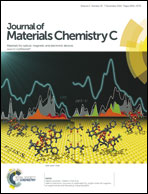trans-Bis(alkylphosphine) platinum(ii)-alkynyl complexes showing broadband visible light absorption and long-lived triplet excited states†
Abstract
Heteroleptic trans-bis(alkylphosphine) platinum(II) bisacetylide complexes Pt-1 and Pt-2 were prepared to achieve broadband absorption of visible light. Two different ethynylBodipy ligands, 2-ethynylBodipy and 2,6-diethynylBodipy or 8-(4′-ethynylphenyl)Bodipy, were used in each complex. Each Bodipy ligand gives strong absorption in the visible spectral region, but at different wavelengths, thus broadband absorption in the visible spectral region was achieved for the Pt(II) complexes (ε is up to 1.85 × 105 M−1 cm−1 in the region of 450–700 nm). Singlet energy transfer from the peripheral coordinated Bodipy to the central coordinated Bodipy (with 2,6-diethynyl substitution) was confirmed by steady state absorption/luminescence spectroscopy, fluorescence excitation spectroscopy and nanosecond/femtosecond ultrafast time-resolved transient absorption spectroscopy. Long-lived triplet excited states were observed for both complexes (τT = 63.13 μs for Pt-1 and τT = 94.18 μs for Pt-2). Nanosecond time-resolved transient absorption spectroscopy indicated that the triplet excited state of Pt-1 is distributed on both Bodipy units. For Pt-2, however, the T1 state is confined to the central coordinated Bodipy ligand. These complexes show high singlet oxygen (1O2) quantum yields (ΦΔ = 76.0%). With nanosecond pulsed laser excitation, delayed fluorescence was observed for the complexes (τDF = 43.8 μs for Pt-1 and τDF = 111.0 μs for Pt-2), which is rarely reported for transition metal complexes. The complexes were used as efficient multi-wavelength excitable triplet photosensitizers for triplet–triplet annihilation upconversion.


 Please wait while we load your content...
Please wait while we load your content...